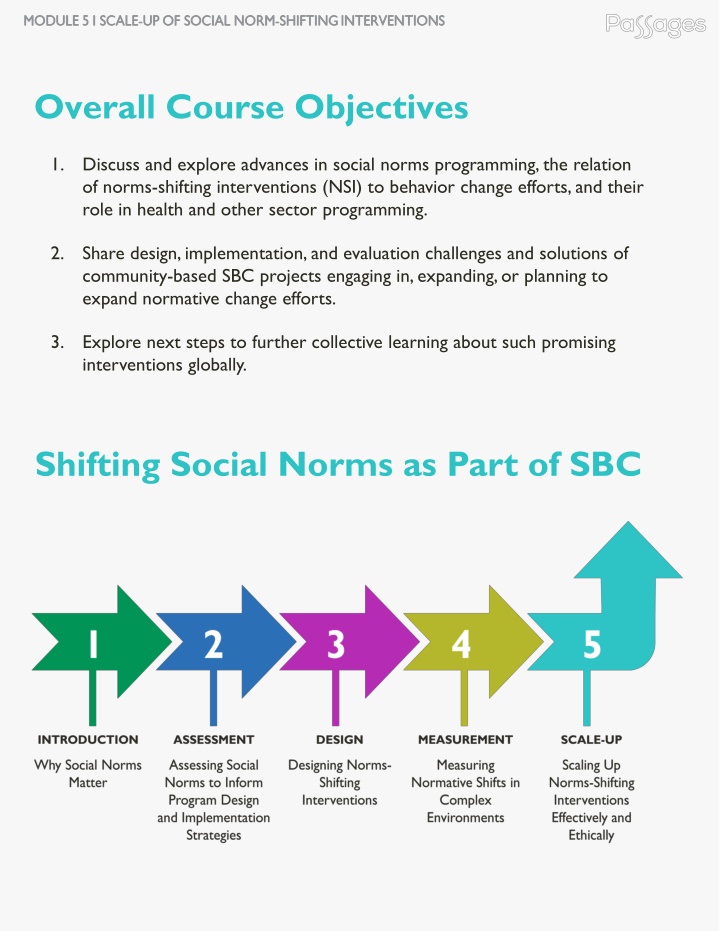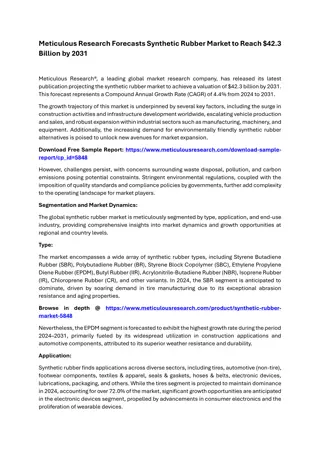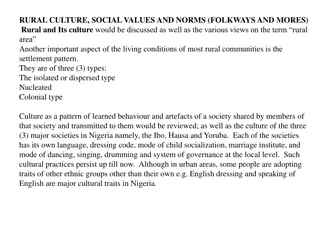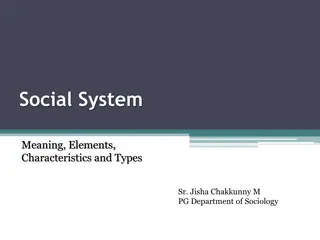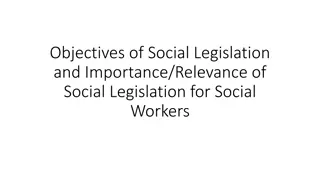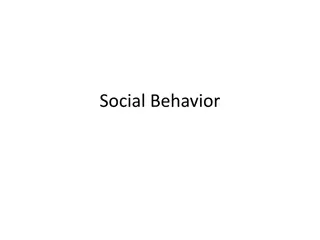Shifting Social Norms as Part of SBC
Participants will discuss social norms programming, NSIs' relation to behavior change efforts, and challenges in community-based SBC projects. The session explores scaling up concepts, adaptation considerations, and designing NSIs for effective implementation.
Download Presentation

Please find below an Image/Link to download the presentation.
The content on the website is provided AS IS for your information and personal use only. It may not be sold, licensed, or shared on other websites without obtaining consent from the author.If you encounter any issues during the download, it is possible that the publisher has removed the file from their server.
You are allowed to download the files provided on this website for personal or commercial use, subject to the condition that they are used lawfully. All files are the property of their respective owners.
The content on the website is provided AS IS for your information and personal use only. It may not be sold, licensed, or shared on other websites without obtaining consent from the author.
E N D
Presentation Transcript
Overall Course Objectives 1. Discuss and explore advances in social norms programming, the relation of norms-shifting interventions (NSI) to behavior change efforts, and their role in health and other sector programming. 2. Share design, implementation, and evaluation challenges and solutions of community-based SBC projects engaging in, expanding, or planning to expand normative change efforts. 3. Explore next steps to further collective learning about such promising interventions globally. Shifting Social Norms as Part of SBC
Overview Assessing Social Norms Learning Objectives During this session, participants will: 1. Discuss key scale-up concepts and considerations that influence adaptation, expansion, and institutionalization of norms-shifting interventions. 2. Develop a perspective of the temporal nature (waves) of scale-up and related technical and management issues to address. 3. Define the seven Guideposts for designing and adapting NSI, monitoring implementation, diffusing new ideas and social shifts, and evaluating NSIs as they are scaled. 4. Begin to apply the concepts, temporal nature, and seven Guideposts in relation to their own projects.
MODULE 5 I SCALE-UP OF SOCIAL NORM-SHIFTING INTERVENTIONS Part 1: Defining the NSI-Innovation MAIN COMPONENTS OF THE INNOVATION PACKAGE SUPPORT ACTIVITIES TO OFFER THE COMPONENT Key activities/strategies, e.g., community-level outreach, mass media campaign, services linkage Needed support actions, e.g.,training, materials Example: High quality training-of-trainers, and high-quality training of mentors to make sure norms-shifting approaches come through clearly during mentoring Example: A mentorship model where community elders work with young men to shift the norms that perpetuate violent discipline of children Part I1: Assessing NSI Scalability HOW SCALABLE IS THE INTERVENTION? YES/NO/ MAYBE COMMENTS/ CONCERNS Relevance and relative advantage Responds to perceived problems? Accounts for community, cultural, gender, other social factors? Tested and shown to be effective? Ease of use by other organizations/programs Simple to use? Easy to integrate into existing programs? Reasonable cost to implement (human, material, financial)? Compatibility with new user organization Aligns with development objectives of receiving organization? Aligned with its organizational values? Sufficient capacity to absorb new activities?
Assessing Scalability: Relevance, Ease, and Compatibility Relevance and relative advantage Responds to perceived problems. Accounts for community, cultural, gender, other social factors. Sufficiently effective to help decrease identified problems. Easy to install Simple to use. Easy to integrate into existing program. Reasonable cost to implement (human, material, financial). Compatible with receiving organization Aligns with development objectives of receiving organization. Aligns with values. Sufficient capacity to absorb new activities. Seven Guideposts for NSI Scale-Up NSI design adaptation during scale-up 1. Understand the NSI s theory of change, its underlying values and change mechanisms, for effective transfer to new organizations. 2. Remember that adaptation is an option, but you need to KISS! 3. Many NSIs operate outside of health systems and need linkages. Monitoring in new contexts 1. Ensure new staff have technical and social change competencies. 2. Monitor whether NSI activities are leading to social change and idea diffusion at the community level. 3. Monitor the receiving social system for unexpected opposition and other unanticipated effects. Evaluation 1. Be multi-dimensional in outcome measurement and move beyond the individual.
At each moment of new-wave expansion, ask: Does the NSI effectively shift norms in the new context? Are new user organizations able to offer the NSI as planned? What is the community capacity in new areas to manage the effects of the NSI? GROUP ACTIVITY T kponon Jikuagou (TJ) T kponon Jikuagou (TJ) addresses communication and gender barriers to talking publicly and privately about family planning and engaging men equally with women on the subject. Pilot impact evaluation showed encouraging effectiveness. Men were less influenced than women vis- -vis norms shifting. Yet TJ sought gender-equal engagement to address family planning needs and method use. Should scale-up continue? If yes, under what conditions? GROUP ACTIVITY FGC Abandonment, Kenya The population in three refugee camps came from a country where female genital cutting (FGC) was universal and socially important but had significant health and social consequences. Camps were stable; most residents had lived five or more years in the camps. Pilot showed that FGC-abandonment activities were effective new attitudes and community expectations around cutting were occurring. The NSI activities were appreciated by camp communities. Should scale-up to new refugee camps be considered? If so, under what conditions?
GROUP ACTIVITY Husbands Schools, Niger In a highly-patriarchal society with high maternal mortality rates, Husbands Schools aimed to engage men in promoting use of RH care by wives. In this context men and women mistrusted and feared services, and men were the deciders. Effectiveness study in Zinder region demonstrated in the pilot phase that the approach was very effective in increasing RH care use, and qualitative evidence showed more couple communication and joint decision making around RH care use. Should this male engagement and gender role-shifting NSI be expanded to new areas of the country? If yes, under what conditions? GROUP ACTIVITY Let s Pull It All Together: Some Reflection Questions 1. As you scale up, how do you adapt NSI? To new organizational contexts? While still maintaining fidelity to normative change? What are the risk management strategies for organizations implementing NSI? Who deals with pushback and how? How will the NSI support positive changes, possibly beyond the mandate of the innovation? What do you see as the differences between norms-shifting interventions and other social and behavior change interventions? 2. 3.
Key Takeaways Scaling-up is a planned process to extend a tested NSI to new areas, new communities, and to create supportive policy and program guidelines, to reach an impact at scale. There is an art and a science to scaling up an NSI. Understanding the totality of the innovation ensures transferability to new contexts, new organizations, new resource teams, and new implementers. Before scaling an NSI, understand how it achieved normative and other outcomes. NSIs, which operate in the normative space, are part of yet unique within SBC efforts. Use the seven guideposts for NSI throughout the scale-up process, from design/adaptation and implementation, to monitoring and evaluating diffusion and social shifts as the NSI is scaled.
Resources The Social Norms Learning Collaborative. Considerations for Scaling Up Norms-Shifting Interventions for Adolescent and Youth Sexual and Reproductive Health. Washington, DC: Institute for Reproductive Health, Georgetown University, 2019. https://www.alignplatform.org/resources/considerations-scaling-norms- shifting-interventions-adolescent-and-youth-sexual-and The Community for Understanding Scale Up (CUSP). On the Cusp of Change: Effective Scaling of Social Norms Programming for Gender Equality. CUSP, 2017. https://www.comminit.com/global/content/cusp-change-effective- scaling-social-norms-programming-gender-equality The Community for Understanding Scale Up (CUSP). Social Norm Change at Scale: CUSP s Collective Insights, in CUSP 2018 Case Study Collection (CUSP, 2018). https://www.youthlead.org/resources/social-norms-change- scale-cusps-collective-insights-2018 Carter, Becky, Marina Apgar, and Shandana Khan Mohmand. Guidance Note on Scaling up Social Norm Change. K4D Emerging Issues Report. Brighton, UK: Institute of Development Studies, 2019. https://www.ids.ac.uk/publications/guidance-note-on-scaling-up-social-norm- change/ Weber, Audrey and Betsy Costenbader. What s Documentation Got to Do With It? Examining the Evidence on Scale-Up of Social Norms Interventions for Adolescent and Youth Reproductive Health. R&E Search for Evidence, Oct. 16, 2019. https://researchforevidence.fhi360.org/whats-documentation- got-to-do-with-it-examining-the-evidence-on-scale-up-of-social-norms- interventions-for-adolescent-and-youth-reproductive-health
